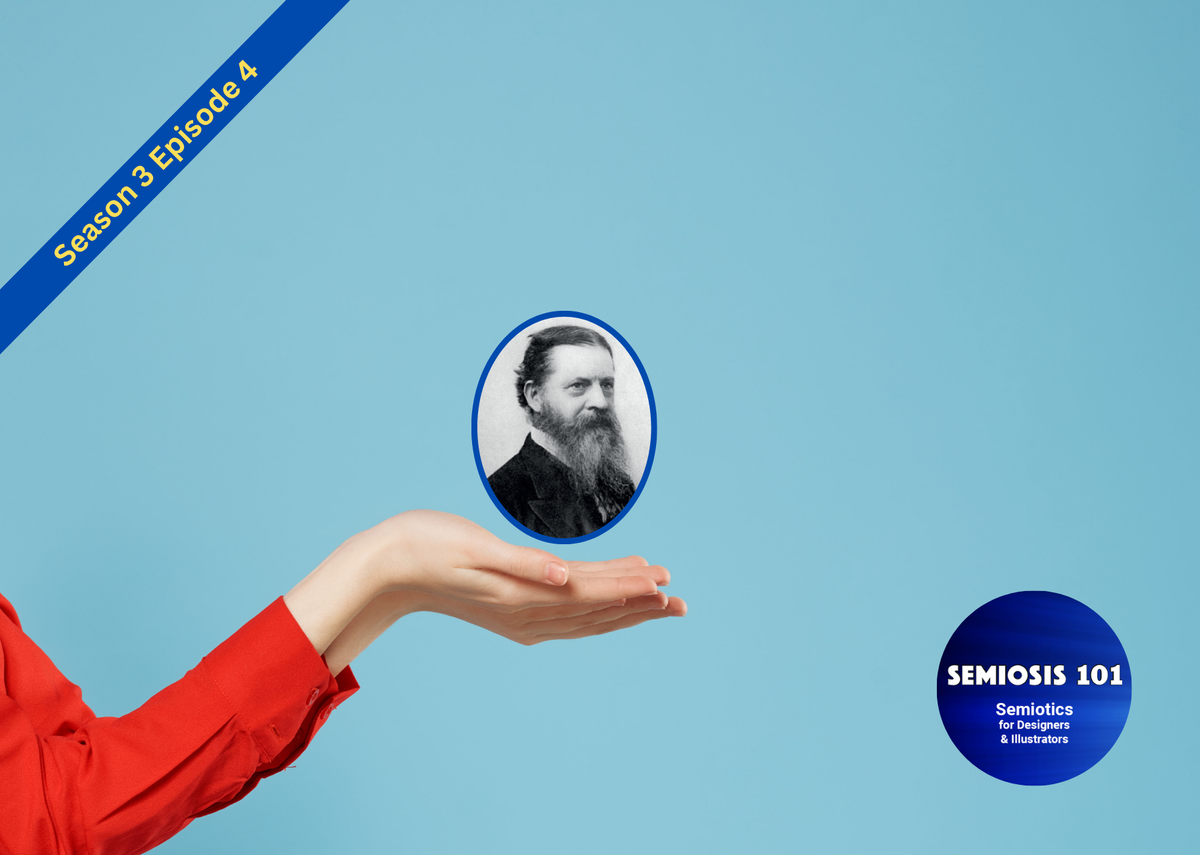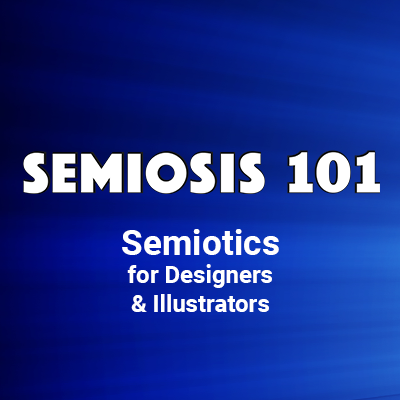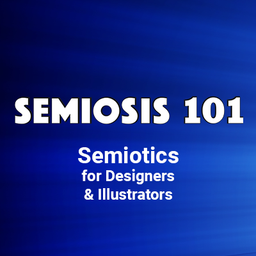Free Semiosis 101 Transcript 3.4:

FINALLY WE VISUALLY UNDERSTAND: Semiotic Meaning-bearing 3
Hello readers.
In this free transcript for the episode published on Semiosis 101 on 8 Nov 2023, we wrap up our dive into how people semiotically interpret. These states are the immediate, the dynamic and the final effects on a semiotic sign’s interpretation. In this episode we will examine the final effect of interpretation.
Watch the free episode on YouTube for the full impact…
…and here is the episode’s transcript.
This week we wrap up our dive into how people semiotically interpret. We have over this month examined Peirce’s three states of the effect the encoded semiotic sign has on how it is interpreted. These states are the immediate, the dynamic and the final effects on a semiotic sign’s interpretation. In this episode we will examine the final effect of interpretation.
Hit subscribe to this YouTube channel, and I will explain…
Over the last three weeks we have been exploring the effect of a semiotic sign on its interpretation. Peirce describes three states of effect that progressively leads the target audience from no perception, to perception of possible meaning, through forming an interpretation. This week we end this discussion on the interpretation. Peirce calls these three states that have an effect on interpretation the Immediate Interpretant, Dynamic Interpretant and Final Interpretant. The Interpretant being Peirce’s word for the effect of the semiotic sign on interpretation.
For Semiosis 101 newbies out there, remember not to get intimidated by Peircean terminology (I did say Peirce’s language was obtuse). Semiosis 101 is here to put Peirce into designer-centric terminology for you. Just keep your focus on the titles immediate, dynamic and final with the word “effect” instead of Interpretant. Semiosis or sign-action is predicated on an inter-relationship of three things working to form meaning. Peirce calls this a determination flow between (HIS WORDS) an Object, its Representamen, and its Interpretant.
Yup I know. As soon as those words are introduced you hear them, but they are unintelligible to any normal creative. You have switched off (hopefully only metaphorically?). So let us on Semiosis 101 translate those terms into terms designers and illustrators will understand and appreciate more.
Let us say the semiotic determination flow is between a concept > its representation > and its interpretation. Therefore we can, in Semiosis 101 terms, describe the three interpretation states as an immediate effect, a dynamic effect and final effect of a semiotic sign on its interpretation. So far we have been using a panda drawing to illustrate this.
Last week we had arrived at the dynamic effect state where the interpreter can… (I insert a caveat here) …put the name “panda” to the pattern of black shapes and lines that are meaning-bearing. This pattern we have interpreted so far coalesces into the overall shape of a possible animal (immediate effect), and this animal is likely to be a mammal, fairly large, and bear-shaped (dynamic effect). The black and white pattern makes the interpreter say “panda.”
Now as I said last week, you probably are not aware of this interpretation flow as it takes milliseconds of subconscious processing …for most of you. Why did I caveat this interpretation just now? The interpretation of “panda” is dependent on the interpreter’s socio-cultural lived experience.
What?
To interpret “panda” from the drawing they needed to know about pandas. If someone had never seen a panda, whether at the zoo, in the wild, on TV, in a photograph, or as a child with a cuddly panda toy, (yes I loved my panda bear as a child!), how could they interpret the drawing as a “panda?”
To the majority the drawing is clearly a “panda.” But without that knowledge of pandas, the interpreter may only interpret the drawing as a “bear.” If they have no socio-cultural knowledge of bears, then the closest their interpretation may get is a “mammal” or an “animal.”
It is the same drawing, but the effect of the visual language it uses has an effect on how it is understood by a target audience. The creative controls how it is mediated. The audience decides what they interpret from the mediation. The drawing is a mediation between the concept to be communicated - a panda - and how the creative decides to represent that concept of a panda through the visual language they choose.
The panda drawing is constructed with black shapes and lines and utilises the white negative spaces to suggest the shape of a bear. These black marks are semiotic Iconic representations to resemble body parts.
Once the audience interprets these random shapes as something (immediate effect), then the same Iconic elements help point the interpreter to name what they see. The semiotic signs now Indexically represent themselves as a panda to the interpreter (dynamic effect).
Yes, I did say signs. Plural.
The drawing is both a semiotic sign as a “bear” and comprises of multiple nested semiotic signs suggesting individual panda body parts.“But that is a drawing not a SIGN?” I hear some of you shout at me. (If you still think we are talking about signage, stop watching this episode and go back and watch the first episode of season two.)
The construction of meaning is the final effect of a semiotic sign on its interpretation. Peirce says this is when the semiotic sign’s effect on the interpretation “tends to represent itself to be related to its [concept].” We see this final effect at work in our drawing example.
How many of you “saw” the panda instantaneously? All the visual elements in the drawing quickly progressed you to a panda interpretation. Once you saw “panda,” the meaning-bearing elements in the drawing had semiotically performed its sign-action effect, from immediate (possibility), through dynamic (mediation) to final (intended interpretation). If the determination flow has been successful, the representation (encoded semiotic signs) of a concept (panda) is clear enough to lead the audience to make the intended interpretation of “panda” …the concept.
Any illustrator or designer can mindfully hone their mark-making visual communication skills to help the interpreter - their intended target audience - to gain the intended meaning. For designers and illustrators the big damascene moment, when trying to apply semiotic theory is, the realisation that a semiotic sign is just encoded meaning. It is not a tangible utilitarian thing you make …like a toilet door sign. Semiosis - semiotic sign-action - is a process YOU creatives can learn to apply to YOUR existing creative processes, to enhance how YOU succeed in visually communicating YOUR intended concept(s).
Semiosis is something you encode into what you create ensuring that it is meaning-bearing. Peirce describes the final effect of a semiotic sign on its interpretation as, “the one interpretative result to which every interpreter is destined to come if the sign is sufficiently considered.” In our panda example, the intended concept is “panda.” All the visual language used, and the aesthetic decisions taken, to form the Iconic shapes into things that identify a panda to the intended audience, is a skill.
Peirce describes this highest final effect state as a “sign of law.” He classes the level the immediate effect performs at as a level of possibilities. (Peirce calls this a Rheme). Next, he classes the dynamic effect as performing at a level of mediated proposals. (Peirce calls this a Dicent). The final effect happens at the phenomenological level of Thirdness and Peirce classes it as an “Argument.” What Peirce means, in creative terms, by calling this level of the final effect an Argument, is that a creative carefully selects visual language to avoid misinterpretation. Or to put it another way, creatives semiotically encode FOR successful interpretation by the intended target audience.
I will leave you on another animal depiction. Is this 12th century Ta Prohm temple carving in Cambodia a stegosaurus? I will wait…
It looks like it is. The carver has carved the pentagonal spinal plates of what we know as a stegosaurus. But how did the carver know what a stegosaurus looked like? To our 21st century eyes the shape we see carved in relief certainly suggests to us, as a final effect, a stegosaurus. But it is a badly visualised water buffalo, or Asian rhino, surrounded by leaf motifs.
The Danish semiotician Thorkild Thellefsen, states “culture determines how we interpret,” and our target audiences will have ways of interpreting. These are based on their own cognition, understanding, knowledge and cultural references.To ensure you reduce your capacity to miscommunicate the intended concept, you can become more mindful of how your designs and illustrations are crafted.
As we have seen over the last three weeks, semiotic interpretation happens at three states: immediate, then dynamic, and onto final. Each state is the effect of the visual language on how it is interpreted. By semiotically controlling the aesthetic decisions, from the Iconic mark-making level up to the finished piece of visual communication, misinterpretation and miscommunication can be minimised. Subscribe to Semiosis 101 and come back next week for more on encoding semiotic signs into your designs and illustrations.
Semiosis 101 Semiotic Design Resources is a reader-supported publication. To receive exclusive posts and support my work, consider becoming a free or paid subscriber. Paid subscribers get name checked on all future Semiosis 101 YouTube episodes.
===Semiosis 101 Patreon Producer==============
Become a Semiosis 101 Patreon Producer and get a named producer credit on future video episodes, plus watch all new episodes months ahead of YouTube.
===Semiosis 101 Patreon Exclusives==============
Watch longer Patreon-exclusive Semiosis 101 episodes on applying Semiosis into design and illustration…
PATEXC001 How does semiotics work in illustration?





